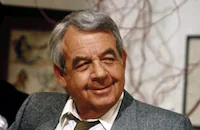The World of Henry Orient had originated as an autobiographical novel by Nora Johnson, daughter of acclaimed screenwriter Nunnally Johnson. The younger Johnson had grown up in New York after her parents' divorce, dreaming of her absent father and hoping that her parents would get back together. In the novel, Nora's stand-in is Val, a sophisticated-beyond-her-years girl who forges a fast friendship with Gil, another girl from a broken home. Together, they develop a mutual crush on superstar pianist Henry Orient, a character based on pianist/actor Oscar Levant.
Nunnally Johnson admired his daughter's work, but didn't see its screen potential when the novel first appeared in 1958. He couldn't envision finding two young actresses who could carry a story like that. Then Hayley Mills and Patty Duke shot to child stardom in the early sixties, and Johnson knew he'd found the film's stars. He bought the screen rights from his daughter, hired her to write the screenplay and even kept her name on the script after re-writing it completely. Then he found that he couldn't work out deals for either young star. Instead, he cast two unknowns, Tippy Walker for the emotionally demanding role of Val and Merrie Spaeth as Gil.
The screenplay already featured an expanded role for Henry Orient, so with no stars available to play the young girls, the Johnsons went looking for a male name to anchor the film. Among those considered were Robert Preston, Rex Harrison, Tony Randall and Dick Van Dyke. Then they offered Peter Sellers the chance to shoot his first film in America, and he jumped at it. He turned the character into a vainglorious delight whose inability to scale the heights of the music world gently mirrored his teenaged fans' dreams of building a new family with him.
The Johnsons were particularly lucky to land George Roy Hill as director. A stage and television veteran, Hill had only directed two films at that point. Both were adaptations of stage work: Tennessee Williams' Period of Adjustment and Lillian Hellman's Toys in the Attic. With The World of Henry Orient, he broke free from the constraints of those stage-bound features to stage a series of elegiac chases through New York. The opening sequences of the two girls cavorting through Central Park represent one of the greatest on-screen tributes to the Big Apple. It was also the first use of slow motion in an American commercial feature. His work wasn't all razzle-dazzle either. Hill forged a close relationship with both young actresses, drawing surprisingly sensitive performances from them. The result was a critical success that became the U.S.' official entry in the 1964 Cannes Film Festival. It also brought the Johnsons a Writers Guild Award for the year's best comedy script.
The success of The World of Henry Orient propelled George Roy Hill to ever-better assignments, including the twenties musical romp Thoroughly Modern Millie (1967), the western blockbuster Butch Cassidy and the Sundance Kid (1969) and his Oscar-winner for Best Picture and Best Director, The Sting (1973).
Bernstein's score for The World of Henry Orient also drew strong reviews, with critics particularly praising his use of the wedding march from Lohengrin for the scene in which the girls discuss their crush on Sellers. Bernstein would later collaborate with Hill on both the epic Hawaii (1966), which brought him Oscar nominations for Best Score and Best Song, and Thoroughly Modern Millie, which brought him his only Oscar to date. He would return to comedy years later when he was discovered by a new generation of directors, including Ivan Reitman (Stripes (1981) and Ghostbusters, 1984) and John Landis (Animal House (1978) and Trading Places, 1983).
Director: George Roy Hill
Producer: Jerome Hellman
Screenplay: Nora Johnson, Nunnally Johnson
Based on the novel by Nora Johnson
Cinematography: Boris Kaufman, Arthur J. Ornitz
Art Direction: James Sullivan
Music: Elmer Bernstein, Ken Lauber
Principal Cast: Peter Sellers (Henry Orient), Paula Prentiss (Stella), Tippy Walker (Valerie Boyd), Merrie Spaeth (Marian "Gil" Gilbert), Angela Lansbury (Isabel Boyd), Phyllis Thaxter (Mrs. Gilbert).
C-107m. Letterboxed.
by Frank Miller































